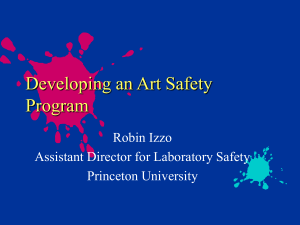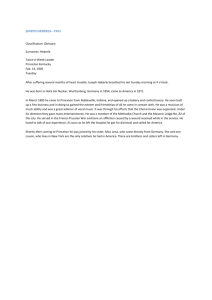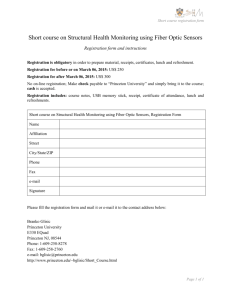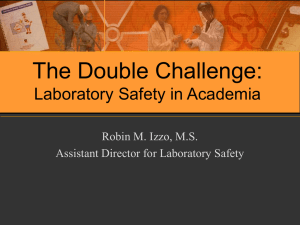Developing Environmental Safety in the Arts
advertisement
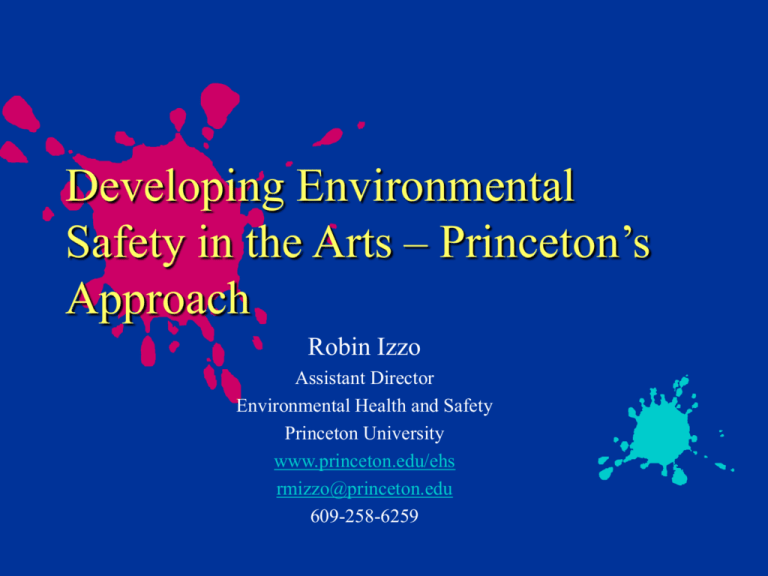
Developing Environmental Safety in the Arts – Princeton’s Approach Robin Izzo Assistant Director Environmental Health and Safety Princeton University www.princeton.edu/ehs rmizzo@princeton.edu 609-258-6259 Epiphany UVM Screen Printing Room Solvent-based inks No ventilation 100+ year old building Vermont Artists Did Consortium VanGogh Die for Art? Visual Arts at Princeton Undergraduate Visual Arts Theater Dance Students have 24 hour access Majors have shared or personal studios 1000 enrolled students in art courses ~500 Visual Arts majors Visual Arts at Princeton ~55 Visual Arts Faculty 22 “permanent” Mostly dance, theater, writing, computer graphics Remainder are “adjunct” faculty Turnover every 1-3 years Most commute from New York City Faculty required to be on campus 2 days per week Usually not in until after 1 PM Visual Arts at Princeton Painting and Drawing Sculpture Lithography Photography Printmaking Ceramics Video Theater and Dance Why an Art Safety Program? Health and safety issues Environmental concerns Fire safety issues Hazard Communication Right to Know Many artists are not familiar with most of these issues Art Hazards Painting Sculpture Photography Ceramics Lithography Theater Environmental Issues RCRA Hazardous Waste Clean Air Act Spray booths Sculpture shop Clean Water Act Ceramics Drain disposal Princeton’s Program Previously treated generically general Hazard Communication Program general Hazard Communication Training Right to Know Inventories Respirator Program Waste Disposal Relatively good shape Princeton’s Program EHS Overall Trend move from broad based programs to specialized programs common problem - expectations not communicated identify goals and objectives, work with department to determine how to make it work based on their needs Princeton’s Program Specialized Training Program all incoming faculty all students review specific issues quiz Inspections Semi-annual EHS inspections Monthly departmental inspections Princeton’s Program Theater Safety Program Staff and student in the Theater Program Student Theater Groups Theater In-Time Triangle Club Training Program On-line Student Theater Safety Guide www.princeton.edu/sites/ehs/theatersafety Princeton’s Program Student Event Theater Safety Training Planning Fire code permits, security needs, etc. Emergency Procedures Set Design and Construction Rigging, power tools, chemical safety, etc. Lighting and Sound Special effects Performance Strike Princeton’s Program Environmental University policy Long-standing EPA, Stewardship policy on regulatory fines OSHA, State, etc. Fines from violations are the responsibility of the department where the violation was noted Department can pass along fines to labs, groups, etc. Princeton Art Safety Training Hazard Communication Program Understanding Chemical Safety Info Spill Cleanup Waste Disposal Medium-Specific Concerns Painting Pigments “hues” Thinners Linseed Oil autoignition Adhesives sensitizers Oil-based paints Turpentine sensitizer - odorless thinner is better alternative Paint Pigments Antimony Arsenic Cadmium Chromium Lead Manganese Mercury True Naples Yellow Cobalt violet Emerald Green All cadmium pigments Resp and GI Irritation Skin/eye/GI irritation CNS disorders, Cancer Lung, kidney, CNS disease High BP, anemia Chromium green, strontium Skin, respiratory irritation yellow, viridian, chrome Allergies yellow, zinc yellow Lung cancer Flake white, mixed white, CNS disorder, GI problems Naples or chrome yellow Burnt amber, Mn blue, Mn Respiratory irritation violet, Mars brown CNS problems Vermillion CNS disease Precautions for Painters Know the what is in your pigments. Use the least toxic. Avoid mixing dry pigments. Avoid hand to mouth contact. Don’t use your mouth to point your brush. Avoid using turpentine - use thinner Use least dusty forms of chalk, pastels, etc. Photography Developer alkaline Stop Bath acetic acid Fixers Disposal problems Reducer Mix with concentrated acid or high heat, can release cyanide gas Many photochemicals are sensitizers Precautions for Photographers Use liquid chemistry Avoid skin exposure Cover baths when not in use. Use pre-mixed chemicals Rinse with water between acid bleach step and fixing steps. (sulfur dioxide gas) Use good ventilation. Ceramics Silica - silicosis sand, perlite, grog, vermiculite Mold - wet clay Musculo-skeletal problems Glazes - metals Skin irritation clay, Kiln glazes - fumes, CO, IR Precautions for Ceramics Use pre-mixed clay. Use good ventilation. Clean daily. Moisturize hands. Avoid lead glazes Use gloves when handling glazes Use good ventilation and CO for kiln Wear IR goggles when looking into kiln Electrical safety and good material handling Sculpture Wood shop - same hazards and concerns as maintenance, etc. Plasters, silica, etc. Spray Paint Clay Paints Mold-making Resins Precautions for Sculptors Use eye and face protection Choose the least hazardous woods and stones Do not use plaster for casting body parts Use good lifting techniques Protect hands against vibration of hand tools Use machining tools under supervision Precautions for Sculptors Take breaks to avoid carpal tunnel syndrome Avoid chlorinated waxes Protect against electrical hazards Wear gloves when applying epoxy glues and hardeners, formaldehyde glues or solvent-based adhesives Lithography/Printmaking Linseed Oil Solvents Sharp Tools Hot Plates Inks Nitric acid contamination solvents disposal with Environmental Concerns Waste disposal solvents, oily oils rags photochemicals acids and bases sharps empty chemical containers glazes Environmental Concerns Drain disposal fixers thinners Air emissions paint spray booths exhaust from woodworking equipment EPA Initiative focus on art department dumpster diving Pollution Prevention Use “hues” High flashpoint solvents (Turpenoid) Baby Oil for brush cleaning Digital photography Silver recovery Recycle everything possible Institutional Recycling Network Getting Started Partnership between department and EHS to determine expectations and requirements Ordered and installed needed materials Mandatory meeting with faculty White tornado of corrective actions Meet with students and faculty to explain new procedures and provide specialized training Getting Started Videotaped meeting and training for those who could not attend. Began frequent inspections. Notified faculty and students about infractions. Included building janitor in training, particular attention on waste disposal. Recruited casual employee to conduct inspections of studios twice weekly. Initiatives Standardized containers Pre-printed labels MSDS proliferation Signage Spill Kits Purchasing Restrictions Waste Disposal Improvements Inspections Standardized Containers Previously - any available glass container often food or drink containers Difficult to identify what was a chemical container vs. a true food container Pre-labeled mason jars required. Lids available - required when material not in use. Pre-Printed Waste Labels Color-coded printed labels provided by EHS for regular waste streams Waste poster with label supply Sample labels affixed to cabinets. MSDSs Always good about keeping MSDSs on hand, but accessibility was an issue. MSDS notebook for every classroom. Clearly labeled. Chained to cabinets. Signage Instructions posted in every room drain disposal restrictions MSDS locations Closing checklist Spill kit locations No excuse for not following procedures Lamination Signage Spill Kits Increased number of spill kits to ensure all areas covered. Provided training on how and when to use them. Purchasing Restrictions Non-majors cannot bring in personal materials Majors have a budget All materials purchased through technician or approved by technician Ensures MSDS availability and hazard assessment Waste Disposal Improvements Clarified expectations Standardized waste containers Standardized labeling Inspections Inspections EHS involved in first rounds Monthly inspections by department staff Weekly inspections of student areas by casual employee Assistance by janitor Public violation notice Inspections Most Common “Violations” noted Incompletely labeled containers Flammable liquid storage cabinets not closed tightly Lids or foil covers missing from individual containers of thinners Rags left on the floor Funnels left in waste containers Labels on containers in cabinet not facing out How Can You Do This? Learn about the issues Find out what your art department does. Familiarize yourself about the issues using reference materials. Determine which issues apply to your institution. How Can You Do This? Find the right people find your champion may not be the department chair or manager educate the people with authority about the issues and the potential consequences people money Work with them to find workable solutions Training Establish a specialized training program. Find a way to include everyone in the training. Not just classroom training faculty pass it onto the students inspections/problem discussion also help educate people Inspect and Follow Up Inspections/follow-up absolutely crucial. Do not drop and dash. Follow it through. Frequent at first, then taper off as improvements made. Feedback to faculty and students. Accountability is crucial. Celebrate successes. Resources Web Sites Center for Safety in the Arts http://artsnet.heinz.cmu.edu:70/0/csa ACTS: Arts, Crafts and Theater Safety http://www.caseweb.com/acts/ Princeton Univ Art Safety Training Guide http://www.princeton.edu/sites/ehs/artsafety Princeton Univ Theater Operations Manual http://www.princeton.edu/sites/ehs/theatersafety Books Artist Beware - Michael McCann, PhD, CIH The Artist’s Complete Health and Safety Guide, Monona Rossol, MS, MFA Overexposure: Photography Hazards -Susan Shaw and Monona Rossol Making Art Safely - M. Spandorfer, D. Curtiss, J. Snyder, MD Stage Fright: Health & Safety in Theater Monona Rossol, MS, MFA Health Hazards Manual for Artists - Michael McCann, PhD, CIH Questions??? A View of Princeton…
